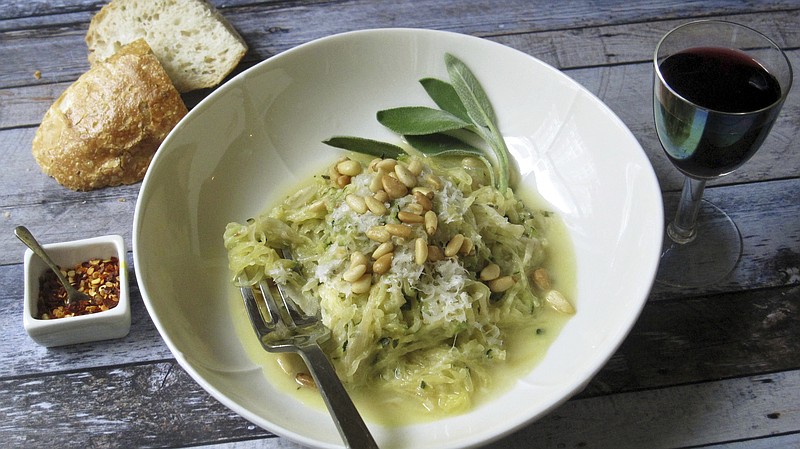Spaghetti squash is a large round squash that forms spaghettilike strands when it's cooked. Its texture is crisp, its taste is mild, and it can indeed replace spaghetti in the recipe of your choice. This is especially good news if you're searching for an alternative to pasta, either because you're allergic to gluten or because you're seeking a more nutritious landing pad for a delicious sauce.
Spaghetti squash can be steamed, roasted or cooked in the microwave. Whatever method is used, the squash cooks much faster if you start by slicing it in half. But you have to be careful - sawing through its thick skin can be dangerous. Happily, just a few minutes in a microwave will soften up the squash enough to alleviate this danger.
After cooking the squash and halving it, I finish it off in the microwave, which tenderizes it in 17 to 20 minutes rather than the 30 to 45 minutes required when it's steamed or roasted. By the way, most recipes instruct you to halve the squash lengthwise, but if you halve it crosswise, as in this recipe, you'll end up with strands that are much longer ... and more spaghettilike.
When the squash has cooled, use a fork to scrape out the strands. Having prepped the squash to this point, you can store it in the refrigerator for a few days until you're ready to prepare a sauce and finish it, an option you can't employ with actual pasta that, because of its starch content, turns into a big gummy wad of stuck-together strands. (You can also freeze spaghetti squash.)
After scooping out the squash strands, add them to the creamy goat cheese sauce, then simmer them for 5 minutes while they soak up the flavor. Again, this is something you can't do with actual spaghetti, which would not only become too soft but also completely absorb all of the sauce if you simmered it at length.
You can pair spaghetti squash with any sauce you would add to regular pasta. Just remember to let the spaghetti squash cook in the sauce - whatever kind it is - for a few minutes before serving.
Spaghetti Squash with Creamy Goat Cheese Sauce and Shredded Zucchini
Start to finish: 1 hour (30 active)
Servings: 4 to 6
1 1/2 pounds zucchini
3/4 teaspoon kosher salt
One 3- to 3 1/2 pound spaghetti squash
1 1/2 cups sliced onion
2 tablespoons extra-virgin olive oil
1 cup vegetable or chicken broth
1 tablespoon finely chopped fresh sage
4 ounces fresh goat cheese, crumbled
1 ounce grated Parmigiano-Reggiano
1/3 cup toasted pine nuts
Coarsely grate the zucchini, preferably using the grating disk of a food processor, toss it in a colander with the salt and let it drain for 20 minutes.
Prick the spaghetti squash in three or four places with a skewer and microwave on high for 4 minutes. Cut in half crosswise and microwave for 5 minutes. Scrape out and discard the seeds and microwave again for 8 minutes or until the strands of squash are easy to scrape out.
Meanwhile, in a large skillet cook the onion in the oil over medium heat, stirring occasionally, until golden, about 8 minutes. Working with one handful at a time, squeeze the zucchini tightly to get rid of excess moisture. Add the squeezed zucchini to the onion and cook over medium heat, stirring for 3 minutes. Transfer to a bowl and reserve the skillet.
Let the spaghetti squash stand until it is cool enough to handle, then scoop out all the strands (you should end up with about 4 1/2 cups). Add the vegetable broth, 1 cup water, the sage and the cheese to the skillet and bring to a boil, whisking. Add the spaghetti squash strands, cover and simmer 5 minutes or until the squash is tender. Add the zucchini and cook for 1 minute more until the mixture is heated through. Stir in the Parmigiano-Reggiano and salt and pepper to taste, transfer to four bowls and top each portion with one-quarter of the nuts.
Nutritional information per serving: 326 calories; 170 calories from fat; 19 grams fat (7 grams saturated; 0 grams trans fats); 43 milligrams cholesterol; 582 milligrams sodium; 31 grams carbohydrates; 8 grams fiber; 14 grams sugar; 14 grams protein.
